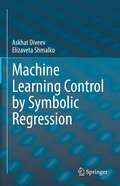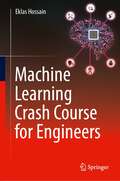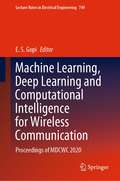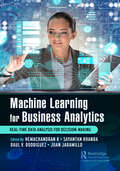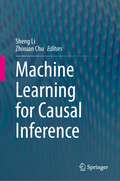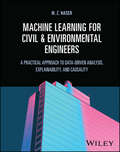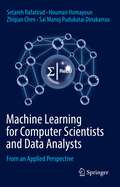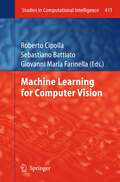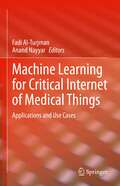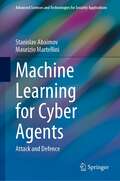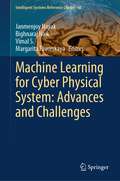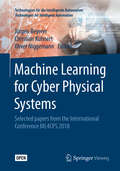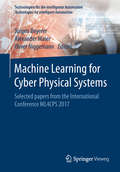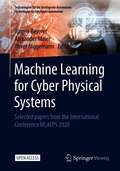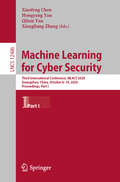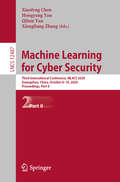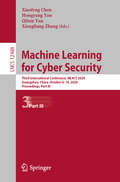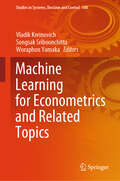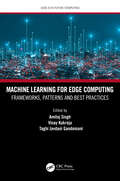- Table View
- List View
Machine Learning Control by Symbolic Regression
by Askhat Diveev Elizaveta ShmalkoThis book provides comprehensive coverage on a new direction in computational mathematics research: automatic search for formulas. Formulas must be sought in all areas of science and life: these are the laws of the universe, the macro and micro world, fundamental physics, engineering, weather and natural disasters forecasting; the search for new laws in economics, politics, sociology. Accumulating many years of experience in the development and application of numerical methods of symbolic regression to solving control problems, the authors offer new possibilities not only in the field of control automation, but also in the design of completely different optimal structures in many fields. For specialists in the field of control, Machine Learning Control by Symbolic Regression opens up a new promising direction of research and acquaints scientists with the methods of automatic construction of control systems.For specialists in the field of machine learning, the book opens up a new, much broader direction than neural networks: methods of symbolic regression. This book makes it easy to master this new area in machine learning and apply this approach everywhere neural networks are used. For mathematicians, the book opens up a new approach to the construction of numerical methods for obtaining analytical solutions to unsolvable problems; for example, numerical analytical solutions of algebraic equations, differential equations, non-trivial integrals, etc. For specialists in the field of artificial intelligence, the book offers a machine way to solve problems, framed in the form of analytical relationships.
Machine Learning Crash Course for Engineers
by Eklas HossainMachine Learning Crash Course for Engineers is a reader-friendly introductory guide to machine learning algorithms and techniques for students, engineers, and other busy technical professionals. The book focuses on the application aspects of machine learning, progressing from the basics to advanced topics systematically from theory to applications and worked-out Python programming examples. It offers highly illustrated, step-by-step demonstrations that allow readers to implement machine learning models to solve real-world problems. This powerful tutorial is an excellent resource for those who need to acquire a solid foundational understanding of machine learning quickly.
Machine Learning, Deep Learning and Computational Intelligence for Wireless Communication: Proceedings of MDCWC 2020 (Lecture Notes in Electrical Engineering #749)
by E. S. GopiThis book is a collection of best selected research papers presented at the Conference on Machine Learning, Deep Learning and Computational Intelligence for Wireless Communication (MDCWC 2020) held during October 22nd to 24th 2020, at the Department of Electronics and Communication Engineering, National Institute of Technology Tiruchirappalli, India. The presented papers are grouped under the following topics (a) Machine Learning, Deep learning and Computational intelligence algorithms (b)Wireless communication systems and (c) Mobile data applications and are included in the book. The topics include the latest research and results in the areas of network prediction, traffic classification, call detail record mining, mobile health care, mobile pattern recognition, natural language processing, automatic speech processing, mobility analysis, indoor localization, wireless sensor networks (WSN), energy minimization, routing, scheduling, resource allocation, multiple access, power control, malware detection, cyber security, flooding attacks detection, mobile apps sniffing, MIMO detection, signal detection in MIMO-OFDM, modulation recognition, channel estimation, MIMO nonlinear equalization, super-resolution channel and direction-of-arrival estimation. The book is a rich reference material for academia and industry.
Machine Learning for Business Analytics: Real-Time Data Analysis for Decision-Making
by Hemachandran K Sayantan Khanra Raul V. Rodriguez Juan JaramilloMachine Learning is an integral tool in a business analyst’s arsenal because the rate at which data is being generated from different sources is increasing and working on complex unstructured data is becoming inevitable. Data collection, data cleaning, and data mining are rapidly becoming more difficult to analyze than just importing information from a primary or secondary source. The machine learning model plays a crucial role in predicting the future performance and results of a company. In real-time, data collection and data wrangling are the important steps in deploying the models. Analytics is a tool for visualizing and steering data and statistics. Business analysts can work with different datasets -- choosing an appropriate machine learning model results in accurate analyzing, forecasting the future, and making informed decisions. The global machine learning market was valued at $1.58 billion in 2017 and is expected to reach $20.83 billion in 2024 -- growing at a CAGR of 44.06% between 2017 and 2024. The authors have compiled important knowledge on machine learning real-time applications in business analytics. This book enables readers to get broad knowledge in the field of machine learning models and to carry out their future research work. The future trends of machine learning for business analytics are explained with real case studies. Essentially, this book acts as a guide to all business analysts. The authors blend the basics of data analytics and machine learning and extend its application to business analytics. This book acts as a superb introduction and covers the applications and implications of machine learning. The authors provide first-hand experience of the applications of machine learning for business analytics in the section on real-time analysis. Case studies put the theory into practice so that you may receive hands-on experience with machine learning and data analytics. This book is a valuable source for practitioners, industrialists, technologists, and researchers.
Machine Learning for Business Analytics: Real-Time Data Analysis for Decision-Making
by Hemachandran K. Sayantan Khanra Raul V. Rodriguez Juan R. JaramilloMachine Learning is an integral tool in a business analyst’s arsenal because the rate at which data is being generated from different sources is increasing and working on complex unstructured data is becoming inevitable. Data collection, data cleaning, and data mining are rapidly becoming more difficult to analyze than just importing information from a primary or secondary source. The machine learning model plays a crucial role in predicting the future performance and results of a company. In real-time, data collection and data wrangling are the important steps in deploying the models. Analytics is a tool for visualizing and steering data and statistics. Business analysts can work with different datasets -- choosing an appropriate machine learning model results in accurate analyzing, forecasting the future, and making informed decisions. The global machine learning market was valued at $1.58 billion in 2017 and is expected to reach $20.83 billion in 2024 -- growing at a CAGR of 44.06% between 2017 and 2024. The authors have compiled important knowledge on machine learning real-time applications in business analytics. This book enables readers to get broad knowledge in the field of machine learning models and to carry out their future research work. The future trends of machine learning for business analytics are explained with real case studies. Essentially, this book acts as a guide to all business analysts. The authors blend the basics of data analytics and machine learning and extend its application to business analytics. This book acts as a superb introduction and covers the applications and implications of machine learning. The authors provide first-hand experience of the applications of machine learning for business analytics in the section on real-time analysis. Case studies put the theory into practice so that you may receive hands-on experience with machine learning and data analytics. This book is a valuable source for practitioners, industrialists, technologists, and researchers.
Machine Learning for Causal Inference
by Sheng Li Zhixuan ChuThis book provides a deep understanding of the relationship between machine learning and causal inference. It covers a broad range of topics, starting with the preliminary foundations of causal inference, which include basic definitions, illustrative examples, and assumptions. It then delves into the different types of classical causal inference methods, such as matching, weighting, tree-based models, and more. Additionally, the book explores how machine learning can be used for causal effect estimation based on representation learning and graph learning. The contribution of causal inference in creating trustworthy machine learning systems to accomplish diversity, non-discrimination and fairness, transparency and explainability, generalization and robustness, and more is also discussed. The book also provides practical applications of causal inference in various domains such as natural language processing, recommender systems, computer vision, time series forecasting, and continual learning. Each chapter of the book is written by leading researchers in their respective fields. Machine Learning for Causal Inference explores the challenges associated with the relationship between machine learning and causal inference, such as biased estimates of causal effects, untrustworthy models, and complicated applications in other artificial intelligence domains. However, it also presents potential solutions to these issues. The book is a valuable resource for researchers, teachers, practitioners, and students interested in these fields. It provides insights into how combining machine learning and causal inference can improve the system's capability to accomplish causal artificial intelligence based on data. The book showcases promising research directions and emphasizes the importance of understanding the causal relationship to construct different machine-learning models from data.
Machine Learning for Civil and Environmental Engineers: A Practical Approach to Data-Driven Analysis, Explainability, and Causality
by M. Z. NaserAccessible and practical framework for machine learning applications and solutions for civil and environmental engineers This textbook introduces engineers and engineering students to the applications of artificial intelligence (AI), machine learning (ML), and machine intelligence (MI) in relation to civil and environmental engineering projects and problems, presenting state-of-the-art methodologies and techniques to develop and implement algorithms in the engineering domain. Through real-world projects like analysis and design of structural members, optimizing concrete mixtures for site applications, examining concrete cracking via computer vision, evaluating the response of bridges to hazards, and predicating water quality and energy expenditure in buildings, this textbook offers readers in-depth case studies with solved problems that are commonly faced by civil and environmental engineers. The approaches presented range from simplified to advanced methods, incorporating coding-based and coding-free techniques. Professional engineers and engineering students will find value in the step-by-step examples that are accompanied by sample databases and codes for readers to practice with. Written by a highly qualified professional with significant experience in the field, Machine Learning includes valuable information on: The current state of machine learning and causality in civil and environmental engineering as viewed through a scientometrics analysis, plus a historical perspective Supervised vs. unsupervised learning for regression, classification, and clustering problems Explainable and causal methods for practical engineering problems Database development, outlining how an engineer can effectively collect and verify appropriate data to be used in machine intelligence analysis A framework for machine learning adoption and application, covering key questions commonly faced by practitioners This textbook is a must-have reference for undergraduate/graduate students to learn concepts on the use of machine learning, for scientists/researchers to learn how to integrate machine learning into civil and environmental engineering, and for design/engineering professionals as a reference guide for undertaking MI design, simulation, and optimization for infrastructure.
Machine Learning for Civil and Environmental Engineers: A Practical Approach to Data-Driven Analysis, Explainability, and Causality
by M. Z. NaserAccessible and practical framework for machine learning applications and solutions for civil and environmental engineers This textbook introduces engineers and engineering students to the applications of artificial intelligence (AI), machine learning (ML), and machine intelligence (MI) in relation to civil and environmental engineering projects and problems, presenting state-of-the-art methodologies and techniques to develop and implement algorithms in the engineering domain. Through real-world projects like analysis and design of structural members, optimizing concrete mixtures for site applications, examining concrete cracking via computer vision, evaluating the response of bridges to hazards, and predicating water quality and energy expenditure in buildings, this textbook offers readers in-depth case studies with solved problems that are commonly faced by civil and environmental engineers. The approaches presented range from simplified to advanced methods, incorporating coding-based and coding-free techniques. Professional engineers and engineering students will find value in the step-by-step examples that are accompanied by sample databases and codes for readers to practice with. Written by a highly qualified professional with significant experience in the field, Machine Learning includes valuable information on: The current state of machine learning and causality in civil and environmental engineering as viewed through a scientometrics analysis, plus a historical perspective Supervised vs. unsupervised learning for regression, classification, and clustering problems Explainable and causal methods for practical engineering problems Database development, outlining how an engineer can effectively collect and verify appropriate data to be used in machine intelligence analysis A framework for machine learning adoption and application, covering key questions commonly faced by practitioners This textbook is a must-have reference for undergraduate/graduate students to learn concepts on the use of machine learning, for scientists/researchers to learn how to integrate machine learning into civil and environmental engineering, and for design/engineering professionals as a reference guide for undertaking MI design, simulation, and optimization for infrastructure.
Machine Learning for Complex and Unmanned Systems
by Jose Martinez-Carranza Everardo Inzunza-González García-Guerrero, Enrique Efrén Esteban Tlelo-CuautleThis book highlights applications that include machine learning methods to enhance new developments in complex and unmanned systems. The contents are organized from the applications requiring few methods to the ones combining different methods and discussing their development and hardware/software implementation. The book includes two parts: the first one collects machine learning applications in complex systems, mainly discussing developments highlighting their modeling and simulation, and hardware implementation. The second part collects applications of machine learning in unmanned systems including optimization and case studies in submarines, drones, and robots. The chapters discuss miscellaneous applications required by both complex and unmanned systems, in the areas of artificial intelligence, cryptography, embedded hardware, electronics, the Internet of Things, and healthcare. Each chapter provides guidelines and details of different methods that can be reproduced in hardware/software and discusses future research.Features Provides details of applications using machine learning methods to solve real problems in engineering Discusses new developments in the areas of complex and unmanned systems Includes details of hardware/software implementation of machine learning methods Includes examples of applications of different machine learning methods for future lines for research in the hot topic areas of submarines, drones, robots, cryptography, electronics, healthcare, and the Internet of Things This book can be used by graduate students, industrial and academic professionals to examine real case studies in applying machine learning in the areas of modeling, simulation, and optimization of complex systems, cryptography, electronics, healthcare, control systems, Internet of Things, security, and unmanned systems such as submarines, drones, and robots.
Machine Learning for Complex and Unmanned Systems
This book highlights applications that include machine learning methods to enhance new developments in complex and unmanned systems. The contents are organized from the applications requiring few methods to the ones combining different methods and discussing their development and hardware/software implementation. The book includes two parts: the first one collects machine learning applications in complex systems, mainly discussing developments highlighting their modeling and simulation, and hardware implementation. The second part collects applications of machine learning in unmanned systems including optimization and case studies in submarines, drones, and robots. The chapters discuss miscellaneous applications required by both complex and unmanned systems, in the areas of artificial intelligence, cryptography, embedded hardware, electronics, the Internet of Things, and healthcare. Each chapter provides guidelines and details of different methods that can be reproduced in hardware/software and discusses future research.Features Provides details of applications using machine learning methods to solve real problems in engineering Discusses new developments in the areas of complex and unmanned systems Includes details of hardware/software implementation of machine learning methods Includes examples of applications of different machine learning methods for future lines for research in the hot topic areas of submarines, drones, robots, cryptography, electronics, healthcare, and the Internet of Things This book can be used by graduate students, industrial and academic professionals to examine real case studies in applying machine learning in the areas of modeling, simulation, and optimization of complex systems, cryptography, electronics, healthcare, control systems, Internet of Things, security, and unmanned systems such as submarines, drones, and robots.
Machine Learning for Computer Scientists and Data Analysts: From an Applied Perspective
by Setareh Rafatirad Houman Homayoun Zhiqian Chen Sai Manoj Pudukotai DinakarraoThis textbook introduces readers to the theoretical aspects of machine learning (ML) algorithms, starting from simple neuron basics, through complex neural networks, including generative adversarial neural networks and graph convolution networks. Most importantly, this book helps readers to understand the concepts of ML algorithms and enables them to develop the skills necessary to choose an apt ML algorithm for a problem they wish to solve. In addition, this book includes numerous case studies, ranging from simple time-series forecasting to object recognition and recommender systems using massive databases. Lastly, this book also provides practical implementation examples and assignments for the readers to practice and improve their programming capabilities for the ML applications.
Machine Learning for Computer Vision (Studies in Computational Intelligence #411)
by Roberto Cipolla Sebastiano Battiato Giovanni Maria FarinellaComputer vision is the science and technology of making machines that see. It is concerned with the theory, design and implementation of algorithms that can automatically process visual data to recognize objects, track and recover their shape and spatial layout. The International Computer Vision Summer School - ICVSS was established in 2007 to provide both an objective and clear overview and an in-depth analysis of the state-of-the-art research in Computer Vision. The courses are delivered by world renowned experts in the field, from both academia and industry, and cover both theoretical and practical aspects of real Computer Vision problems. The school is organized every year by University of Cambridge (Computer Vision and Robotics Group) and University of Catania (Image Processing Lab). Different topics are covered each year. A summary of the past Computer Vision Summer Schools can be found at: http://www.dmi.unict.it/icvss This edited volume contains a selection of articles covering some of the talks and tutorials held during the last editions of the school. The chapters provide an in-depth overview of challenging areas with key references to the existing literature.
Machine Learning for Critical Internet of Medical Things: Applications and Use Cases
by Fadi Al-Turjman Anand NayyarThis book discusses the applications, challenges, and future trends of machine learning in medical domain, including both basic and advanced topics. The book presents how machine learning is helpful in smooth conduction of administrative processes in hospitals, in treating infectious diseases, and in personalized medical treatments. The authors show how machine learning can also help make fast and more accurate disease diagnoses, easily identify patients, help in new types of therapies or treatments, model small-molecule drugs in pharmaceutical sector, and help with innovations via integrated technologies such as artificial intelligence as well as deep learning. The authors show how machine learning also improves the physician’s and doctor’s medical capabilities to better diagnosis their patients. This book illustrates advanced, innovative techniques, frameworks, concepts, and methodologies of machine learning that will enhance the efficiency and effectiveness of the healthcare system.Provides researchers in machine and deep learning with a conceptual understanding of various methodologies of implementing the technologies in medical areas;Discusses the role machine learning and IoT play into locating different virus and diseases across the globe, such as COVID-19, Ebola, and cervical cancer;Includes fundamentals and advances in machine learning in the medical field, supported by significant case studies and practical applications.
Machine Learning for Cyber Agents: Attack and Defence (Advanced Sciences and Technologies for Security Applications)
by Maurizio Martellini Stanislav AbaimovThe cyber world has been both enhanced and endangered by AI. On the one hand, the performance of many existing security services has been improved, and new tools created. On the other, it entails new cyber threats both through evolved attacking capacities and through its own imperfections and vulnerabilities. Moreover, quantum computers are further pushing the boundaries of what is possible, by making machine learning cyber agents faster and smarter. With the abundance of often-confusing information and lack of trust in the diverse applications of AI-based technologies, it is essential to have a book that can explain, from a cyber security standpoint, why and at what stage the emerging, powerful technology of machine learning can and should be mistrusted, and how to benefit from it while avoiding potentially disastrous consequences. In addition, this book sheds light on another highly sensitive area – the application of machine learning for offensive purposes, an aspect that is widely misunderstood, under-represented in the academic literature and requires immediate expert attention.
Machine Learning for Cyber Physical System: Advances and Challenges (Intelligent Systems Reference Library #60)
by Janmenjoy Nayak Bighnaraj Naik Vimal S. Margarita FavorskayaThis book provides a comprehensive platform for learning the state-of-the-art machine learning algorithms for solving several cybersecurity issues. It is helpful in guiding for the implementation of smart machine learning solutions to detect various cybersecurity problems and make the users to understand in combating malware, detect spam, and fight financial fraud to mitigate cybercrimes. With an effective analysis of cyber-physical data, it consists of the solution for many real-life problems such as anomaly detection, IoT-based framework for security and control, manufacturing control system, fault detection, smart cities, risk assessment of cyber-physical systems, medical diagnosis, smart grid systems, biometric-based physical and cybersecurity systems using advance machine learning approach. Filling an important gap between machine learning and cybersecurity communities, it discusses topics covering a wide range of modern and practical advance machine learning techniques, frameworks, and development tools to enable readers to engage with the cutting-edge research across various aspects of cybersecurity.
Machine Learning for Cyber Physical Systems
by Jürgen Beyerer Christian Kühnert Oliver NiggemannThis Open Access proceedings presents new approaches to Machine Learning for Cyber Physical Systems, experiences and visions. It contains some selected papers from the international Conference ML4CPS – Machine Learning for Cyber Physical Systems, which was held in Karlsruhe, October 23-24, 2018. Cyber Physical Systems are characterized by their ability to adapt and to learn: They analyze their environment and, based on observations, they learn patterns, correlations and predictive models. Typical applications are condition monitoring, predictive maintenance, image processing and diagnosis. Machine Learning is the key technology for these developments.
Machine Learning for Cyber Physical Systems: Selected papers from the International Conference ML4CPS 2017 (Technologien für die intelligente Automation #11)
by Jürgen Beyerer Alexander Maier Oliver NiggemannThe work presents new approaches to Machine Learning for Cyber Physical Systems, experiences and visions. It contains some selected papers from the international Conference ML4CPS – Machine Learning for Cyber Physical Systems, which was held in Lemgo, October 25th-26th, 2017. Cyber Physical Systems are characterized by their ability to adapt and to learn: They analyze their environment and, based on observations, they learn patterns, correlations and predictive models. Typical applications are condition monitoring, predictive maintenance, image processing and diagnosis. Machine Learning is the key technology for these developments.
Machine Learning for Cyber-Physical Systems: Selected papers from the International Conference ML4CPS 2023 (Technologien für die intelligente Automation #18)
by Jürgen Beyerer Oliver Niggemann Christian Kühnert Maria KrantzThis open access proceedings presents new approaches to Machine Learning for Cyber-Physical Systems, experiences and visions. It contains some selected papers from the international Conference ML4CPS – Machine Learning for Cyber-Physical Systems, which was held in Hamburg (Germany), March 29th to 31st, 2023. Cyber-physical systems are characterized by their ability to adapt and to learn: They analyze their environment and, based on observations, they learn patterns, correlations and predictive models. Typical applications are condition monitoring, predictive maintenance, image processing and diagnosis. Machine Learning is the key technology for these developments.This is an open access book.
Machine Learning for Cyber Physical Systems: Selected papers from the International Conference ML4CPS 2020 (Technologien für die intelligente Automation #13)
This open access proceedings presents new approaches to Machine Learning for Cyber Physical Systems, experiences and visions. It contains selected papers from the fifth international Conference ML4CPS – Machine Learning for Cyber Physical Systems, which was held in Berlin, March 12-13, 2020. Cyber Physical Systems are characterized by their ability to adapt and to learn: They analyze their environment and, based on observations, they learn patterns, correlations and predictive models. Typical applications are condition monitoring, predictive maintenance, image processing and diagnosis. Machine Learning is the key technology for these developments.
Machine Learning for Cyber Security: Third International Conference, ML4CS 2020, Guangzhou, China, October 8–10, 2020, Proceedings, Part I (Lecture Notes in Computer Science #12486)
by Xiaofeng Chen Hongyang Yan Qiben Yan Xiangliang ZhangThis three volume book set constitutes the proceedings of the Third International Conference on Machine Learning for Cyber Security, ML4CS 2020, held in Xi’an, China in October 2020.The 118 full papers and 40 short papers presented were carefully reviewed and selected from 360 submissions. The papers offer a wide range of the following subjects: Machine learning, security, privacy-preserving, cyber security, Adversarial machine Learning, Malware detection and analysis, Data mining, and Artificial Intelligence.
Machine Learning for Cyber Security: Third International Conference, ML4CS 2020, Guangzhou, China, October 8–10, 2020, Proceedings, Part II (Lecture Notes in Computer Science #12487)
by Xiaofeng Chen Hongyang Yan Qiben Yan Xiangliang ZhangThis three volume book set constitutes the proceedings of the Third International Conference on Machine Learning for Cyber Security, ML4CS 2020, held in Xi’an, China in October 2020.The 118 full papers and 40 short papers presented were carefully reviewed and selected from 360 submissions. The papers offer a wide range of the following subjects: Machine learning, security, privacy-preserving, cyber security, Adversarial machine Learning, Malware detection and analysis, Data mining, and Artificial Intelligence.
Machine Learning for Cyber Security: Third International Conference, ML4CS 2020, Guangzhou, China, October 8–10, 2020, Proceedings, Part III (Lecture Notes in Computer Science #12488)
by Xiaofeng Chen Hongyang Yan Qiben Yan Xiangliang ZhangThis three volume book set constitutes the proceedings of the Third International Conference on Machine Learning for Cyber Security, ML4CS 2020, held in Xi’an, China in October 2020.The 118 full papers and 40 short papers presented were carefully reviewed and selected from 360 submissions. The papers offer a wide range of the following subjects: Machine learning, security, privacy-preserving, cyber security, Adversarial machine Learning, Malware detection and analysis, Data mining, and Artificial Intelligence.
Machine Learning for Econometrics and Related Topics (Studies in Systems, Decision and Control #508)
by Vladik Kreinovich Songsak Sriboonchitta Woraphon YamakaIn the last decades, machine learning techniques – especially techniques of deep learning – led to numerous successes in many application areas, including economics. The use of machine learning in economics is the main focus of this book; however, the book also describes the use of more traditional econometric techniques. Applications include practically all major sectors of economics: agriculture, health (including the impact of Covid-19), manufacturing, trade, transportation, etc. Several papers analyze the effect of age, education, and gender on economy – and, more generally, issues of fairness and discrimination.We hope that this volume will:help practitioners to become better knowledgeable of the state-of-the-art econometric techniques, especially techniques of machine learning,and help researchers to further develop these important research directions. We want to thank all the authors for their contributions and all anonymous referees for their thorough analysis and helpful comments.
Machine Learning for Edge Computing: Frameworks, Patterns and Best Practices (ISSN)
by Amitoj SinghThis book divides edge intelligence into AI for edge (intelligence-enabled edge computing) and AI on edge (artificial intelligence on edge). It focuses on providing optimal solutions to the key concerns in edge computing through effective AI technologies, and it discusses how to build AI models, i.e., model training and inference, on edge. This book provides insights into this new inter-disciplinary field of edge computing from a broader vision and perspective. The authors discuss machine learning algorithms for edge computing as well as the future needs and potential of the technology. The authors also explain the core concepts, frameworks, patterns, and research roadmap, which offer the necessary background for potential future research programs in edge intelligence.The target audience of this book includes academics, research scholars, industrial experts, scientists, and postgraduate students who are working in the field of Internet of Things (IoT) or edge computing and would like to add machine learning to enhance the capabilities of their work. This book explores the following topics: Edge computing, hardware for edge computing AI, and edge virtualization techniques Edge intelligence and deep learning applications, training, and optimization Machine learning algorithms used for edge computing Reviews AI on IoT Discusses future edge computing needs Amitoj Singh is an Associate Professor at the School of Sciences of Emerging Technologies, Jagat Guru Nanak Dev Punjab State Open University, Punjab, India.Vinay Kukreja is a Professor at the Chitkara Institute of Engineering and Technology, Chitkara University, Punjab, India.Taghi Javdani Gandomani is an Assistant Professor at Shahrekord University, Shahrekord, Iran.
Machine Learning for Edge Computing: Frameworks, Patterns and Best Practices (ISSN)
by Amitoj Singh Vinay Kukreja Taghi Javdani GandomaniThis book divides edge intelligence into AI for edge (intelligence-enabled edge computing) and AI on edge (artificial intelligence on edge). It focuses on providing optimal solutions to the key concerns in edge computing through effective AI technologies, and it discusses how to build AI models, i.e., model training and inference, on edge. This book provides insights into this new inter-disciplinary field of edge computing from a broader vision and perspective. The authors discuss machine learning algorithms for edge computing as well as the future needs and potential of the technology. The authors also explain the core concepts, frameworks, patterns, and research roadmap, which offer the necessary background for potential future research programs in edge intelligence.The target audience of this book includes academics, research scholars, industrial experts, scientists, and postgraduate students who are working in the field of Internet of Things (IoT) or edge computing and would like to add machine learning to enhance the capabilities of their work. This book explores the following topics: Edge computing, hardware for edge computing AI, and edge virtualization techniques Edge intelligence and deep learning applications, training, and optimization Machine learning algorithms used for edge computing Reviews AI on IoT Discusses future edge computing needs Amitoj Singh is an Associate Professor at the School of Sciences of Emerging Technologies, Jagat Guru Nanak Dev Punjab State Open University, Punjab, India.Vinay Kukreja is a Professor at the Chitkara Institute of Engineering and Technology, Chitkara University, Punjab, India.Taghi Javdani Gandomani is an Assistant Professor at Shahrekord University, Shahrekord, Iran.
